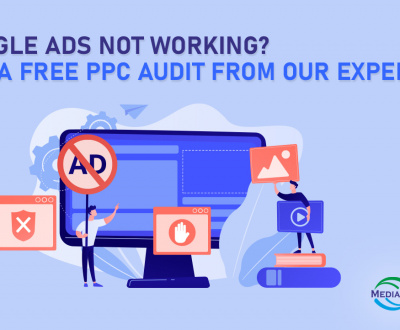What Is GA4 Conversion Tracking — And Why It Matters for Google Ads Success
- July 23, 2025
- GA4
Universal Analytics is history, and Google Analytics 4 (GA4) is the future. For many, it is just an analytical upgrade, but experts have a different opinion on GA4. Google has launched GA4, and it is here to stay. So, it is better to learn about it – process and purpose.
If you recall, Universal Analytics focused only on website activities such as page views, clicks, and form submissions. It is called a session-based data model that gives limited data on customer journeys.
GA4 tracks the entire customer journey. It provides the tools with which you can easily track user behavior like never before. It is called an event-based model, and it has made conversion tracking more critical than ever.

The shift from session-based tracking to event-based tracking is strategic in many ways. GA4 tracks user behavior across platforms to provide deeper insight into the customer journey. Unlike its predecessor, GA4 creates a cookieless digital landscape to respect privacy laws. Simply put, it doesn’t stalk customers. It goes behind them like their shadows, providing insights for measuring ROI and optimizing marketing strategies.
What can you expect? A new set of tools, advanced features, and predictive insights make customer tracking more critical than ever.
What Is GA4 Conversion Tracking?
Before you jump to any conclusion on Google Analytics 4 (GA4), you should understand the necessity of conversion tracking. Every time a visitor comes to your site, you want to check their source and activities to understand the prompt that brought them there and the trigger that encouraged them to take the desired action or click back.
GA4 conversion tracking provides more flexible and detailed insights into user behavior across multiple platforms and devices. Instead of relying on default metrics, you can define events, such as signing up for a newsletter or adding products to a wish list, aligning with your business goal for conversion tracking.
Comparing GA4’s approach to conversion tracking with Universal Analytics (UA)
UA’s Approach
It followed a session-based model where user interactions were grouped into sessions. A session is a time-based period of activity, and UA records only one goal per session, irrespective of how many goals a user completes in a session. UA was solely based on cookies and provided limited cross-platform tracking.
GA4’s Approach
Google upgraded the session-based tracking to event-based tracking in GA4. It defines an event as an activity or action. This model allows flexibility to choose events, like downloads and clicks, for conversion tracking. You can see a user’s journey to your website and identify the touch points that drove the user to take desired actions.
Key Differences:
1. Event-based: GA4 tracks everything that comes within the purview of events. Event tracking is the need of the hour. It is the best way to track and document user journeys.
2. Manual Conversion Marking: GA4 allows the manual selection of events for conversion tracking. It is a deviation from the simpler goal-based system introduced by Universal Analytics.
3. More Flexible Tracking: GA4 is better suited for cross-platform tracking. The advanced version of Google Analytics follows users wherever they go, documenting their behavior for a detailed analysis. UA had limited cross-platform compatibility.
4. Google Tag Manager (GTM): In GA4, it deploys tags without modifying website code. This simplification of tracking codes was missing in the previous UA tracking. GTM speeds up the tracking setup across websites and apps for accurate data collection.
5. Enhanced Measurement: This built-in feature in GA4 automates the necessary settings, such as site search, scrolls, outbound clicks, and file downloads. It provides deeper behavioral insights necessary for monitoring key activities.
6. Data Modeling: In GA4, machine learning fills missing data without breaching privacy laws or cookie limitations. It ensures more accurate reporting, including user behavior and conversions.
Why Does GA4 Conversion Tracking Matter?
GA4 conversion tracking is here to stay and helps websites in many ways. It can highlight the user journey to your site and events, driving users to take desired actions. This advanced conversion tracking model can help businesses in the following ways:
1. Better User Journey Insights
Only GA4 has the features that can provide deeper insights into how users interact with websites or apps. They can track and document every step in the user journey. Here’s the breakdown of how GA4 collects insights on user journeys:
Enhanced Exploration Capabilities: GA4 starts tracking the user journey from the source and highlights every step users take leading to events. It also notices the drop-off points.
Detailed Event Tracking: It allows for the implementation of custom tracking events across platforms or devices. You can choose events to track.
Leveraging Segments: Create segments based on factors such as geographic location and behavior patterns to understand how user behavior varies across segments.
2. More accurate ROAS/ROI reporting
GA4 allows for improving ROAS (Return on Ad Spend) and ROI (Return on Investment) with a smart reporting tool:
- Verify purchase revenue tracking by including the value parameter in every purchase event. It will represent the total transaction amount.
- Non-ecommerce websites can set up custom events such as form submissions and downloads, and assign value parameters to them.
- Link GA4 with advertising platforms, such as Google Ads and Meta to import cost data.
- Create behavior-based segments to optimize campaigns and improve ROAS.
- Utilize the AI chat feature to get expert guidance on how to improve your reporting and analysis.
3. Cross-platform + cross-device tracking
GA4 helps achieve cross-platform and cross-device tracking in the following ways:
- Assign unique user IDs to authenticated users and track their journeys, irrespective of their platforms or devices.
- GA4 recognizes Google account holders and starts tracking their activities across platforms if they visit your website or app.
- GA4 doesn’t use cookies because they are often declined. It employs machine learning to fill the gaps created in user journeys.
- GA4 can track users across multiple domains. This feature makes this conversion tracking model suitable for websites with multiple domains.
4. Privacy-first data collection
GA4 has in-built privacy features that make it special for conversion tracking.
- It prioritizes first-party data, minimizing reliance on third-party cookies.
- It collects necessary data, minimizing privacy risks.
- GA4 encrypts data for added safety.
- GA4 exercises data retention control to minimize time for personal data usage.
GA4 Conversion Tracking Checklist
1. Set Up Basic GA4 Property
- Sign in to Google Analytics using your Google Account or create a new account.
- Enter the site, click + Create Property, and enter the property name, reporting time zone, and currency to create a property.
- Set up a data stream, such as a website, Android app, or iOS app for data collection.
- Add the GA4 tracking code to your website. You can use a global site tag (gtag.js) or Google Tag Manager (GTM).
- Verify tracking by visiting your website in another tab. Your activities will appear in the tab if you make the accurate settings.
2. Link GA4 to Google Ads
- Sign into Google Analytics and open the GA4 property you want to link.
- The gear icon in the lower-left corner is the admin. Click it to access the Property column and click Google Ads Links.
- Find the blue “Link” button on the top right and click it. Select the Google Ads account you want to link and confirm the settings.
- Enable personalized advertising or auto-tagging to configure link settings and submit.
- Check whether you can see your Google Ads account listed under Google Ads Links. Recheck the setting if you don’t, or you can hire a Google Ads consultant.
3. Key Conversions
These are crucial activities reflecting various business objectives:
- Purchase: Completing a sale
- Form Submission: Sharing contact details, starting an inquiry, or giving a lead by filling out a form
- Sing-Up: Visitors registering or creating accounts
- Add to Cart: Products added to carts
- Begin Checkout: Visitors initiating checkout
- File Download: Visitors downloading files, like PDFs or brochures
- Newsletter Subscription: Sign up for email or newsletter
- App Install: Application download and installation
- Video Engagement: Viewing marketing videos, like product demo
- Booking or Reservation: Visitors requesting appointment or reserving tickets
4. Test with DebugView
Enable DebugView to ensure all settings are correctly made in GA4. You will see real-time data. It will also help identify and fix any issues with the tracking setup.
View events in DebugView
Visit your website and click on a link to perform a test action. Open your GA4 to check the following:
- Activity timeline
- Events performed
- Conversion events
DebugView helps in:
- Confirming the events are tracked
- Custom parameters are being passed
- Conversion tracking is validated
- Cross-platform or platform behavior
Red Flags: Common Mistakes & What to Avoid
1. Not marking important events as conversions
It is difficult to measure performance with crucial conversion data missing in reports. With no defined conversions, you could waste your budget on users who don’t convert. Your ROI tracking will be nowhere to locate sources of specific leads.
2. Relying solely on automatic event tracking
Auto settings don’t align with specific goals, as critical events, like purchases, require manual tracking. It also excludes detailed parameters, like product name, and is not optimized for business goals.
3. Forgetting to configure GTM triggers
Not assigning a trigger to every tag is a costly mistake. You will miss critical data in events. Choosing the wrong trigger could fire the wrong data. Unmarked conversions aren’t registered and lead to poor campaign optimization.
4. Duplicate or conflicting events
It’s a critical problem, leading to double-counting of events, inflating conversion rate, conflicting parameter values, and misleading attribution of duplicate events.
Case Example: GA4 Conversion Tracking in Action
Client: A cosmetics company making organic products
Goal: Improve conversion tracking with GA4
Before GA4 implementation:
The client was struggling with Universal Analytics (UA), which could provide limited help with conversion tracking. The session-based model could hardly help beyond pageviews. It can track one conversion per session, even when a session has multiple events.
They had the following problems:
- Issues with data discrepancies
- Inability to track specific user interactions
- Challenges in locating effective sources
- Vulnerability to privacy laws
- Lacking predictive analysis
After G4A implementation:
The company switched to GA4 hoping for improvement in its conversion tracking and ROI. The company hires a GA4 expert to set up a property and starts the new generation conversion tracking.
They get the following:
- Cross-platform tracking with a detailed view of user behavior
- Ability to track minute interactions, like button clicks, video engagement, and form submission
- Better understanding of the customer journey and budget allocation
- Privacy-first conversion tracking
- Inventory optimization with predictive analysis
Milestones achieved with GA4:
Activating GA4 helped the company achieve critical milestones. It made significant progress in the highly competitive market. You can see the progress in numbers.
- Event-based conversion tracking improved the conversion rate by 15%
- With better attribution data, the company made a steady progress of 20% on ad spend
- Identifying high-bounce rate landing pages helps decrease the bounce rate by 10%
- Tracking video views resulted in a 25% increase in engagement rate
- Segmenting audiences based on their location, preferences, and browsing data improved personalized marketing
Conclusion
Switching to GA4 helped the cosmetics company reach the targeted audience. Event-based conversion tracking provided valuable insight into customer behavior and optimized its marketing for desired results.
Call to Action
Need help with your GA4 setup? Get a free audit today. Universal Analytics has been discontinued, and GA4 is the latest version. It features advanced tracking tools. Setting up GA4 requires a good understanding of how Google Analytics works in the changed environment. A mistake could cost you dearly in terms of viewers and budget.
If you have already set up GA4 but not getting the expected results. Blame it on the silly mistakes you could have made in settings. Let’s fix those mistakes for you before the Q4 begins and assure you of the desired results at the end of the quarter. You can cover a long distance in a short time with GA4.
Media Challengers, led by Birendra Kumar, is the foremost SEO and PPC services company, specializing in implementing a comprehensive range of online marketing techniques to enhance business profitability. As a Google certified agency partner, we bring expertise in SEO (Search Engine Optimization) and PPC (Pay-Per-Click) strategies to drive successful digital campaigns.
Do you want an instant result and traffic?
You are at the right place, we are committed for instant result (Call, Query Form, Traffic, view, etc..) generation. If you have any questions please let me know.
Our last month campaign performance

Recent Posts
- How Much Does Google Ads Really Cost for the US market? (2025 Budget Guide) September 25, 2025
- Google Ads Not Working? Get a Free PPC Audit from Our Experts September 7, 2025
- Top 10 Google Ads Mistakes That Waste Your Budget (And How to Fix Them) August 11, 2025











